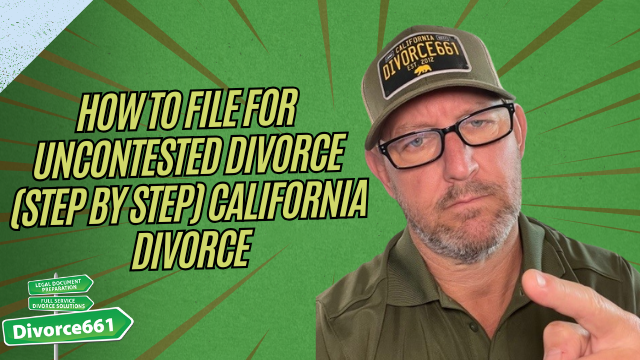How To File For UNCONTESTED Divorce (Step by Step) California Divorce
Filing for an uncontested divorce in California is one of the most straightforward ways to end a marriage when both parties agree on the major issues. With the right forms, clear steps, and attention to deadlines, you can complete the process without courtroom battles or lengthy hearings.
Every form, step by step.
Who this process is for
This approach works when both spouses agree on key issues: division of property and debts, child custody and support if applicable, spousal support, and any other outstanding matters. If there are disputes or complex financial or custody issues, consider getting legal advice.
Overview of the process
- Prepare the required forms.
- File the forms at the courthouse and pay the filing fee or request a fee waiver.
- Legally serve the other spouse with the papers and file proof of service.
- Exchange required financial disclosures.
- Submit settlement documents or default/Judgment paperwork to finalize the divorce.
Step-by-step instructions
1. Gather and complete the basic forms
Common California family law forms for an uncontested divorce include:
- Petition (Marriage/Domestic Partnership) — starts the case.
- Summons — notifies the other party of the filing and legal deadlines.
- Proof of Service — shows the other party was properly served.
- Declaration Under UCCJEA — required if you have children under 18.
- Income and Expense Declaration and Schedule of Assets and Debts — used for support and property division.
Get these forms from the California Courts website or your county court’s self-help center. Fill them out neatly and accurately. Missing or incorrect information slows everything down.
2. File the forms with the court
Take the completed forms to the family law clerk in the county where either spouse lives. You will pay a filing fee unless you qualify for a fee waiver. When the clerk files your documents, they will stamp them with a court date and case number.
3. Serve the other spouse
The other spouse must be served with the filed documents by someone over 18 who is not a party to the case. After service, complete the Proof of Service form and file it with the court. Proper service is critical; without it the case cannot proceed.
4. Exchange financial disclosures
California requires both parties to exchange financial disclosures so settlement and support decisions are based on full information. This usually includes pay stubs, tax returns, bank statements, and the completed Schedule of Assets and Debts.
5. Reach and document the agreement
If both parties are in agreement, prepare a Marital Settlement Agreement or a proposed Judgment that outlines the terms. Be specific about division of property, debts, custody and visitation, child and spousal support, and who pays attorney fees if applicable.
6. Finalize the divorce
Submit the signed settlement and any required judgment forms to the court. In many uncontested cases the judge can sign the Judgment without a hearing. Once the judge signs and the Judgment is filed, the divorce is final. California has a mandatory waiting period of six months from the date the other spouse was served.
Timeline and important deadlines
- Service response period: The served spouse typically has 30 days to respond after being served.
- Mandatory waiting period: California requires a minimum six-month waiting period from service to final judgment.
- File Proof of Service: File immediately after service to keep the case moving.
Fees and fee waivers
Counties charge filing and other court fees. If you cannot afford the fees, you can apply for a fee waiver by submitting the court’s fee waiver paperwork. Provide accurate income and asset information. If approved, filing fees and some other fees will be waived.
Common mistakes to avoid
- Not properly serving the other party or forgetting to file the Proof of Service.
- Failing to exchange full financial disclosures before submitting settlement documents.
- Using vague language in settlement agreements that leaves room for future disputes.
- Missing the six-month waiting period expectation and assuming the divorce is immediate after filing.
- Skipping legal help when complex assets, taxes, or custody concerns are involved.
Where to get help
Use the local family law facilitator or court self-help center for guidance on forms and procedures. Many county courts post fillable forms and step-by-step checklists online. If the case involves significant assets, complex support calculations, or contested custody, consult an attorney for advice tailored to your situation.
Final tips
- Be organized: Keep copies of everything you file and receive from the court.
- Be transparent: Complete and honest financial disclosures prevent later disputes or sanctions.
- Be specific: Spell out terms clearly in any settlement to avoid ambiguity.
- Ask questions: Court clerks and self-help centers can explain procedural steps, but they cannot give legal advice.
Following a clear, methodical process makes an uncontested divorce manageable. With the correct forms, timely service and disclosures, and a signed agreement, you can move through the process efficiently and fairly.

